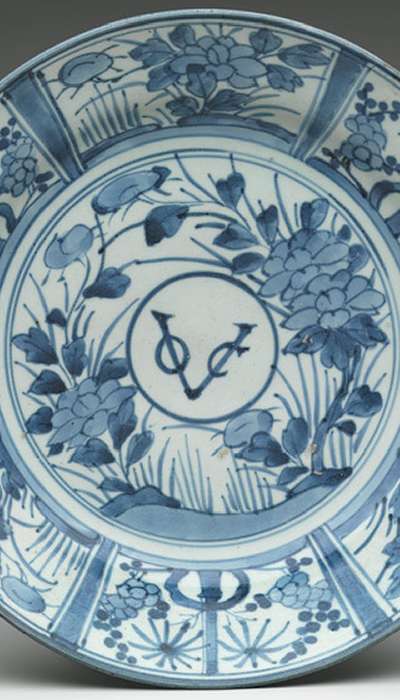
Plate with the initials of the Vereenigde Oost-Indische Compagnie (VOC). Japanese Edo period (1615–1868), ca. 1660, Underglaze blue decoration, Arita ware. Although the Dutch brought many wares back to Europe, the dishes inscribed VOC were intended only for officers of the company
The VOC actually stands for the Verenigde Oostindische Compagnie or The United East India Company. It was founded March 20, 1602 as a result of the joining of forces of several small Dutch trading companies, all having the common goal of increasing trade with the East Indies. The Dutch had first arrived in Asia in 1596, and persisted for several years as independent traders, making a small profit, but with a loss of up to two thirds of their ship's crew each round trip (Pijl-Ketel 1982:9).
VOC's purpose was also to fight the enemies of the state, and to try to prevent other European nations from expanding trade in the region. The traders were thus given the power to represent the Dutch Government and adjudicate in their new territory, to maintain armed forces, enter treaties and produce coinage. These activities left a fascinating and more often than not frightening history.
The VOC was granted a monopoly of trade from the Cape of Good Hope eastwards to the Strait of Magellan, and sovereign rights to all territory acquired in the region.
The main trade route of the VOC was from the Netherlands southward in the Atlantic then around the Cape (Cape Town, South Africa established in 1652 as a provisioning stop) and eastward to the Indies.
Initially lacking a base representative VOC merchants were sent to entrepots that were not under strong Portuguese control such as Banten on the northwest coast of Java, Johore at the southern end of the Malay Peninsula, and Patani on the east coast of the Isthmus of Kra. It was not until 1619 the headquarters in Asia was established by Jan Pieterszoon Coen (1587-1629) as Batavia, Indonesia, booming by the late 1600s, on the old site of Indonesian city of Jacarta, now renamed back to Jakarta.
From 1605-65 Spain and the Netherlands fought an intractable war in the region, as a result of which Portugal (part of Spain from 1580-1640) lost virtually all of its territory in the Indonesian archipelago, the Malay Peninsula, Ceylon, the Malabar Coast and Japan. The British were driven out of the Malay region and the Moluccas.
In the late 1660s the VOC owned 40 war vessels and 160 merchantmen, and had a payroll of over 10,000 soldiers.
During most of the Edo period (1615–1868), the Dutch were the only Europeans allowed to trade with Japan. They were confined to the small man-made island of Deshima, off the coast of Nagasaki, from which point they acquired Japanese porcelain.
Commercially the company was initially highly successful. Its charter was renewed for financial recompense to the government every two decades. In the first 94 years of business, the dividends paid to shareholders never fell below 12 percent, and rose as high as 63.
After 1700 the company declined however, due to the loss of Formosa, declining trade in Japanese silver, competition from other nations, internal bickering, and dissatisfaction with its treatment of local residents.
By 1798 the company was bankrupt and profitless, and was taken over by the Batavian Republic.
Many of the ships of the VOC were wrecked, in sites ranging from the North Sea to the very harbor of Batavia (Jakarta). A rich heritage of artifacts has been recovered from them, including porcelain and China, pepper and spices, indigo and dies, wood, cooking vessels, armaments and shipboard equipment.
Very few of the porcelain pieces in the use of the VOC were ever marked and fakes with the VOC mark added to heighten interest, abounds today. Everything from clumsy South East Asian pieces that would not fool anyone except the most optimistic bargain hunters, to real good pieces, mostly looking as if they were Japanese.
A